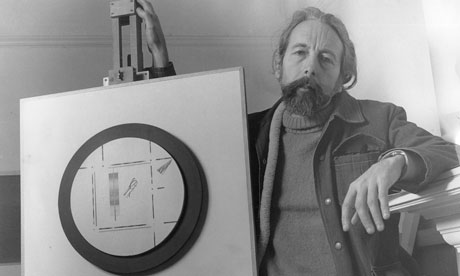
Smith in 1974. He was 'a true visionary, refusing to make concessions to tastefulness, or mere picture-making'.
Jack Smith, who has died aged 82, was one of four artists known as the Beaux Arts quartet in the early 1950s. The other three were John Bratby, Derrick Greaves and Edward Middleditch. All were realists, which was practically a condition for exhibiting at Helen Lessore's famously homely Beaux Arts gallery in Bruton Place, central London, where all had solo shows. All fine and good, until the critic David Sylvester published an article in the December 1954 issue of Encounter magazine about neorealist painters, of whom the Beaux Arts foursome were the focus. The troublesome heading was "The Kitchen Sink". Instantly, the four painters unwillingly became the kitchen sink school.
Encounter illustrated the article with Bratby's Still Life With Chip Frier and Smith's Children and Dog (the emblematic kitchen sink painting), in which Smith showed a scruffy little girl and a woebegone dog playing on uncovered floorboards beside a table littered with the debris of a meal and, for the sake of still life rather than realism, scattered groups of fruit and vegetables. Sylvester withheld approval: "The kitchen is furnished like a poor man's kitchen," he wrote, "but the painter might equally well have been painting a rich man's drawing room for all the difference it would have made." (As it happened, the kitchen was part of the Buckinghamshire house that Smith shared with Greaves, the sculptor of brilliant bricolages George Fullard, and their families.)
Worse than Sylvester's chilly disapproval was John Berger's warm embrace. Berger, who was feuding with Sylvester, and most other critics, in the 1950s proclaimed the kitchen sink group as artists who, in effect, were helping the working classes to achieve their inheritance. Smith at one point remarked that had he been born in a castle, he would be painting pictures of chandeliers, which constituted a rebuff to both Sylvester and Berger. In any case, Smith and Bratby were equally appalled at the kitchen sink label. Greaves had already moved away from realism by the time Sylvester's article appeared ("I was a teenage social realist," he later quipped). Middleditch developed a form of darkly imaginative abstraction.
While all this was happening, Smith had only recently (1952) graduated from the Royal College of Art. He was born in Sheffield and educated there at Netheredge grammar school before moving on to Sheffield college of art in 1944. In 1946 he was called up for national service in the RAF, somehow contriving to combine being a teleprinter operator with servicing flying boats. St Martin's School of Art in London followed in 1948 and, from 1950, the RCA, where two of his tutors, John Minton and Carel Weight, undoubtedly encouraged his inclination to paint subjects from his own life.
In 1956 Smith married Sue Halkett, and showed a group of five paintings in the British Pavilion in the Venice Biennale, alongside the other three Beaux Arts realists, the abstractionist Ivon Hitchens and the sculptor Lynn Chadwick.
The following year, he won first prize at the first John Moores exhibition in Liverpool, with his remarkable canvas Creation and Crucifixion, an apotheosis of all the kitchen tables and chairs, all the plank floors, all the wet shirts hanging on clothes lines he had ever painted bathed in an intense, dreamlike light. This was where he had been going. It was more Stanley Spencer than the early Van Gogh of The Potato Eaters to which his work had been compared, and it pointed, not to an art for the lucky proletariat, but to an inner vision that he was to express in extraordinary and singular abstracts, often compared to hieroglyphs or musical notations. It was an exploration that was to occupy him throughout the last 50 years of his life.
In 1965 the art director Bryan Robertson included him in the plush and – unusually for a wrist-breaking coffee table book – historically useful Private View, written with John Russell and with photographs by Lord Snowdon. Smith was, Robertson wrote, "a true visionary", uncompromising, and "refusing to make concessions to tastefulness, or mere picture-making". In 1971 Smith became the youngest to have a solo show at the Whitechapel Gallery. His change of direction had alienated Lessore, but in the following years he had shows at Marlborough Fine Art, Fischer Fine Art, the Mayor Gallery and the Grosvenor Gallery, among many others, as well as around the world. From 1990, Smith showed frequently at Flowers East in Kingsland Road, east London.
His wife, Sue, survives him.
• Jack Smith, artist, born 18 June 1928; died 11 June 2011
No comments:
Post a Comment